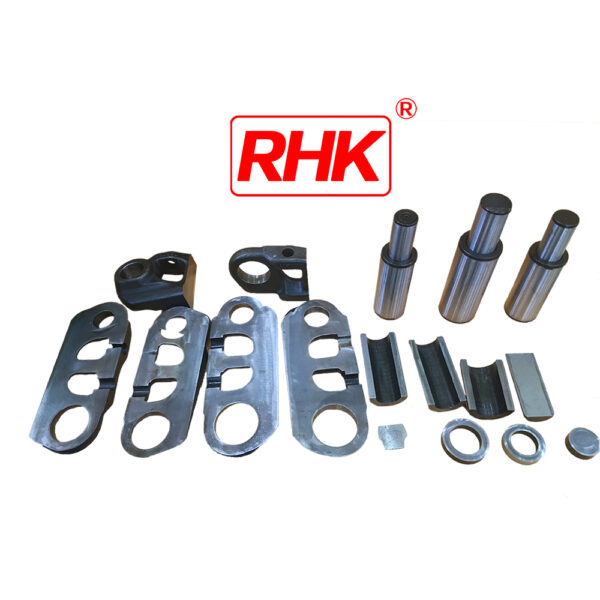Environmental factors such as temperature and terrain significantly impact the lifespan of excavator links:
- Temperature:
- Extreme Heat: High temperatures can accelerate wear and fatigue on excavator links, particularly in components subjected to friction and stress. Heat can cause material fatigue, reduced hardness, and accelerated wear, shortening the link’s lifespan.
- Extreme Cold: Cold temperatures can make materials more brittle, leading to increased susceptibility to fractures or cracking, especially in areas experiencing high stress. Cold conditions may also affect lubrication efficiency, increasing friction and wear.
- Terrain:
- Abrasive Environments: Harsh terrains, such as rocky or abrasive surfaces, accelerate wear on excavator links. Constant contact with abrasive materials leads to faster erosion of link surfaces, reducing their lifespan.
- Soft or Muddy Ground: Working in soft or muddy ground conditions puts additional stress on excavator links as the machine struggles with traction and stability. Continuous slippage or excessive force to navigate such terrain can accelerate wear.
- Moisture and Corrosion:
- Moisture and humidity can lead to corrosion, especially in areas with poor drainage or prolonged exposure to water. Corrosion weakens the material, reducing the link’s structural integrity and lifespan.
- Chemical Exposure:
- Exposure to certain chemicals, such as acids or corrosive substances present in some working environments, can accelerate corrosion and material degradation, impacting the link’s lifespan.
- Load and Usage:
- Heavy loads, frequent heavy impacts, or continuous high-stress operations in harsh environments can hasten wear and fatigue on excavator links, shortening their lifespan.
To mitigate these effects and extend the lifespan of excavator links:
- Regular maintenance, including proper lubrication and inspections, helps to address wear issues early.
- Selecting materials designed to withstand specific environmental conditions or opting for specialized coatings or treatments can improve resistance to wear, corrosion, and temperature extremes.
- Adapting operational practices to reduce excessive stress or strain on the links, especially in challenging terrains, can help extend their lifespan.
Understanding and managing the impact of environmental factors on excavator links is crucial for optimizing their performance, reducing downtime, and ensuring safe and efficient equipment operation.
What are the signs that indicate a excavator link needs replacement or maintenance?
Several signs indicate that an excavator link requires replacement or maintenance:
- Excessive Wear: Visible signs of wear on the surface of the link, such as grooves, thinning, or significant material loss, suggest that the link is nearing the end of its service life and may need replacement.
- Cracks or Fractures: Any cracks, fractures, or deformities on the link, particularly in high-stress areas, indicate structural weaknesses that compromise the link’s integrity and necessitate immediate attention.
- Looseness or Laxity: Excessive play, movement, or looseness in the link connections or joints, excavator link beyond normal operational tolerances, indicates wear in the components or improper tension, necessitating adjustment or replacement.
- Uneven Wear Patterns: Irregular or uneven wear patterns across the surface of the link, particularly in comparison to adjacent components, may indicate misalignment, poor lubrication, or excessive stress, requiring investigation and potential replacement.
- Corrosion or Rust: Corrosion, rust formation, or pitting on the link’s surface, especially in areas exposed to moisture or corrosive elements, signal a weakening of the material and the need for maintenance or replacement.
- Reduced Performance: Any decrease in the equipment’s overall performance, such as decreased stability, excessive vibrations, or reduced maneuverability, could be attributed to issues with the link and necessitate inspection or replacement.
- Abnormal Noises: Unusual noises during operation, such as grinding, squeaking, or clicking, might indicate problems with the link components, including excessive wear or misalignment.
- Increased Track Tension: Frequent adjustments beyond normal maintenance intervals for track tension could suggest issues with the link or other undercarriage components that require inspection.
- Visual Inspection: Regular visual inspections during routine maintenance can reveal signs of wear, damage, or abnormalities that indicate the need for further investigation or replacement.
Addressing these signs promptly through proper maintenance, lubrication, and timely replacement of worn or damaged excavator links is crucial for ensuring safe and efficient equipment operation while minimizing downtime and costly repairs.

Comments